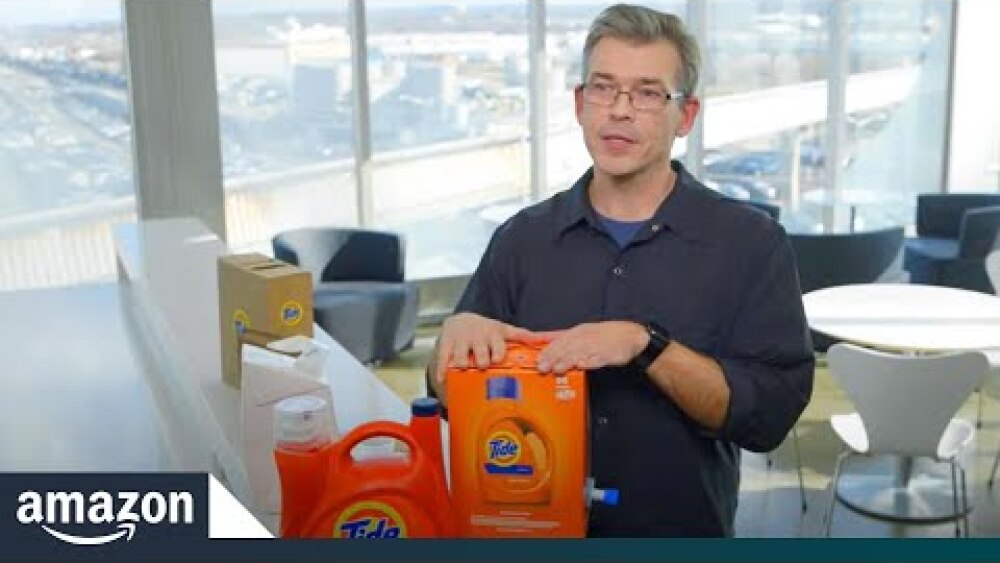FBA Sellers
Lower fulfillment costs and minimize waste with custom packaging
Introduction_to_Ships_in_Product_Packaging_Captioned.mp4
With Ships in Product Packaging, your Fulfillment by Amazon (FBA) orders are delivered in your own custom packaging—without any Amazon-added material. This reduces your fulfillment costs and can help lower your carbon footprint.
The program is open for enrollment through Seller Central to all sellers who use FBA and sell into the following marketplaces: United States, Canada, France, Germany, Italy, Spain and the United Kingdom.

Lower fulfillment fees
Review the discount rates for FBA fee tier based on shipping weight and type and calculate your savings.
View the FBA fee discounts per SIPP-certified unit
In 2026 we will make changes to the SIPP rate card. Click ‘view savings chart’ for details.
Connect with customers
Customize your packaging to display your brand and product messages and improve the unboxing experience.
Improve sustainability
Avoid unnecessary packaging, reduce the weight of deliveries, and decrease the number of trucks on the road.
Get Started: Path to Certification
Getting started
Step 1. Review & design
To enroll in the program, begin by reviewing your current catalog then evaluate and update your packaging design to meet the Ships in Product Packaging requirements outlined below.
Navigate to the “Eligible Products” tab on the SIPP portal in Seller Central to view your eligible products. Access the Seller Central regional pages here: United States, Canada, United Kingdom, Germany, France, Italy, Spain.
Navigate to the “Eligible Products” tab on the SIPP portal in Seller Central to view your eligible products. Access the Seller Central regional pages here: United States, Canada, United Kingdom, Germany, France, Italy, Spain.
Flexible and rigid SIPP packaging requirements
Flexible SIPP products are packaged with flexible exterior such as plastic or paper bags, and rigid or padded mailers that are sealed and the packaging material is at least 2 millimeters thick.
Rigid SIPP products are items shipped in rigid, six-sided packaging such as boxes.
Visit our packaging solutions library for inspiration
Step 2. Group similar ASINs
Evaluate the ASINs that are eligible to be grouped and certified by a single test report. Eligible products should be grouped based on size, weight, material, packaging, product to packaging ratio, pack quantity with a few exceptions.
Primary product
Heaviest and largest product of the ASIN group
Size variation
Up to 25% smaller than the primary product in a single dimension or in total volume
Weight variation
Up to 25% less than the weight of the primary product
Material composition
Material composition of the primary and secondary products must be identical
Packaging type and specifications
Packaging type, structure, and material for all products in the group must be identical
Product to packaging ratio
The ratio of product volume to packaging volume must be similar between primary and secondary products
Pack quantity
The primary and secondary products must have the same number of units in a pack
Step 3. Test and Evaluate
To enroll products and qualify for the SIPP program, all packaging must pass physical performance tests through a self-drop test or International Safe Transit Association (ISTA) 6 lab test. Once the packaging has been updated to meet SIPP requirements, test the largest/heaviest ASIN in the group. Amazon has partnered with the ISTA to develop comprehensive test methods for items in both rigid and flexible packaging that simulate the journey of a package through the Amazon fulfillment network.
Follow steps 3a-3d below if self-testing, OR steps 3a-3b if testing is performed by lab.
Follow steps 3a-3d below if self-testing, OR steps 3a-3b if testing is performed by lab.
3a. Determine if you can self-test or have an ISTA 6 lab test your packaging
Self-test
Applicable if product is non-fragile, and does not contain liquids or sharp items, and is not granular with a diameter <1”
ISTA 6 Lab Test
If your product is fragile, OR contains sharp items, OR contains liquids, you cannot self-test. You will need to submit an ISTA-6A lab report from an ISTA-6 lab in Amazon’s APASS network for certification
3b. Complete the appropriate test
There are 2 main steps to completing the self-test. For flexible packaging, there is an additional step to ensure material strength of the packaging. Pre-test and post-test photos of packaging and item are required for both rigid and flexible packaging. Step 3d provides further instructions on photo requirements.
Numbering
- Rigid
- Flexible
Drop testing
- Rigid
- Flexible
Material Strength Test
For flexible packaging only
3c. Evaluate product and packaging after self-testing
After self-testing is complete, the packaging must pass the below two steps to determine if the product can be certified.
Does your product have:
- visible damage or breakage?
- loss of function or utility?
- compromised seal or tape?
Would your customers:
- accept any of the noticeable signs of wear on the outer or inner packaging that are not listed in 1?







